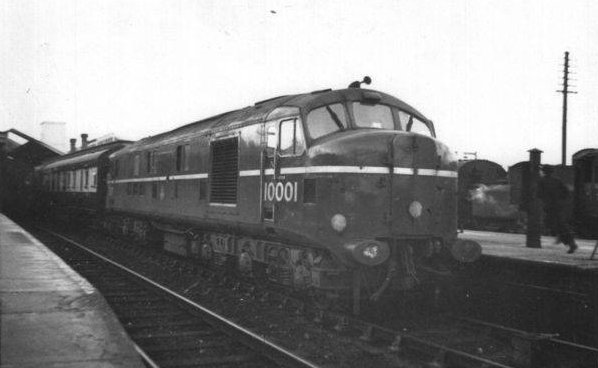- British Rail Class D16/1
Infobox Locomotive
name = LMS 10000 & 10001
(British Rail class D16/1)
powertype = Diesel-electric
caption = 10001 atBletchley , 1954
roadnumber = 10000–10001
builder = LMSDerby Works
builddate = 1947–1948
ordernumber = LMS Lot number 198
gauge = RailGauge|ussg|lk=on
totalproduction = 2
primemover = English Electric 16SVT Mark 1
rpmrange = 750 (max)
transmission = DC generator
DC traction motors
tractionmotors = EE 519/3B, 6 off
uicclass = Co'Co'
wheeldiameter = convert|3|ft|6|in|m|3|abbr=on
minimumcurve =
trainbrakes = Vacuum
brakeforce =
wheelbase = convert|51|ft|6|in|m|2|abbr=on
length = convert|61|ft|2|in|m|2|abbr=on
width =
height =
weight = convert|127.65|LT later convert|130.65|LT
topspeed = convert|93|mph|abbr=on
poweroutput = convert|1600|hp|abbr=on
tractiveeffort = convert|41400|lbf|kN|1|abbr=on
fuelc
convert|900|impgal|abbr=on|lk=on
trainheating = Clarkson Steam generator, later replaced by Spanner convert|2000|lb per hour model
multipleworking = Fitted
powerclass = 6P5F, later 5P5F, later Type 3
axleloadclass = RA 9
retiredate = 1963, 1966
railroad =London, Midland and Scottish Railway ,British Railways British Railways Class D16/1 or 10000 and 10001 were the first mainline
diesel locomotive s inGreat Britain . They were built by theLondon, Midland and Scottish Railway at itsDerby Works , using the EE16SVT 1600 hpdiesel engine with electric transmission, in association withEnglish Electric and theVulcan Foundry , with whom the LMS had had a long working relationship.Early years
10000 had its maiden run in November
1947 , and after several weeks of proving trials entered service on the Midland route in February 1948. 10000 was outshopped only two months before nationalisation, and when 10001 appeared in July 1948 it had British Railways livery. They operated over a number of routes out of St Pancras or Euston but their low power outputs meant they were less than inspiring when used on heavily loaded or express services.Trials
In March
1953 they were both transferred to theSouthern Region of British Railways to allow direct comparison to be made between them and the SR's 10201, 10202 & 10203 and remained there until spring 1955. They (and the SR locomotives) were sent to Derby where they were overhauled and received green livery and then run side by side on London Midland Region duties.Developments
Trials of both types proved interesting, with the Southern Railway locomotives developing into the English Electric Type 4 design for British Railways (later
British Rail Class 40 ). Contrary to popular belief the LMS locomotives did not develop into the British Railways Type 4 (later class 44, 45, 46) but a large part of the design was used to produce the North British Type 4 diesel hydraulic locomotives for theWestern Region of British Railways (numbered D600 to D604).Withdrawals
Both locos were allocated to Willesden. 10001 was withdrawn in
1962 and scrapped at Cox & Danks, North Acton, in February 1968. 10000 was withdrawn in1966 and scrapped at Cashmores, Great Bridge, in January 1968.References
*cite book | last = Hunt | first = David | title = LMS locomotive Profiles Vol. 9: Main Line Diesel-Electrics Nos. 10000 and 10001 | publisher = Wild Swan Publications | date = 2005 | isbn = 1 905184 04 2
*cite book | last = Whitehouse | first = P. | coauthors = St. John Thomas, D. | title = LMS 150. The London, Midland and Scottish Railway: A century and a half of progress | publisher = David and Charles | date = 2002
* Marsden, C.J., http://www.therailwaycentre.comExternal links
* http://gallery34587.fotopic.net/c91503.html
* http://gallery62603.fotopic.net/c180935.html
Wikimedia Foundation. 2010.
